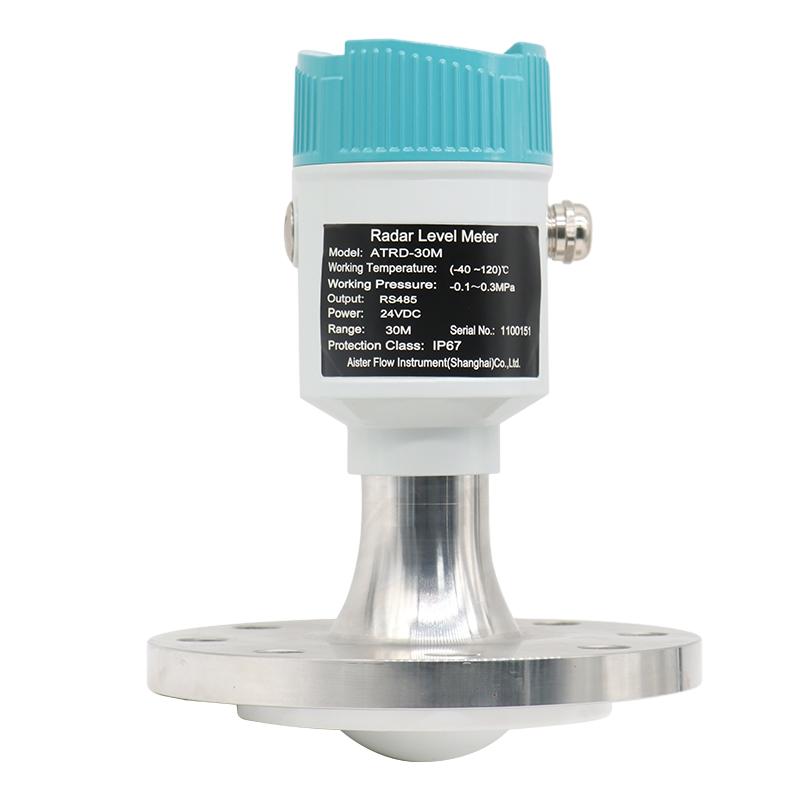How to deal with distortion during the use of radar level meter
2024-03-19
Distortion in radar level measurements can be caused by various factors, and addressing these issues is crucial to ensure accurate and reliable readings. Here are some common strategies to deal with distortion in radar level meters:

Antenna Selection:
Choose the appropriate antenna type for the specific application. Different antennas have varying beam angles and focusing capabilities. Selecting the right antenna helps minimize the impact of obstacles, such as tank internals, pipes, or agitators, on the radar signal.
Antenna Placement:
Proper positioning of the antenna is essential. Avoid placing the antenna too close to tank walls, baffles, or other obstructions that may cause signal reflection or absorption. Optimal antenna placement helps reduce interference and distortion.
Signal Frequency Adjustment:
Some radar level meters allow for adjustments in signal frequency. Modifying the frequency can help mitigate interference caused by certain materials or conditions within the tank. Experimenting with different frequencies may improve signal accuracy.
Signal Damping and Filtering:
Implement signal damping and filtering techniques to reduce noise and interference. Signal processing features in radar level meters can be adjusted to filter out unwanted signals and enhance the accuracy of level measurements.
Signal Averaging:
Use signal averaging functionality to smooth out fluctuations in the radar signal. Averaging can help improve measurement stability and reduce the impact of short-term distortions caused by turbulence or agitation in the tank.
False Echo Suppression:
Many modern radar level meters include features for false echo suppression. These features are designed to identify and eliminate spurious signals caused by reflections from nearby structures or interfering objects.
Installation of Stillpipes or Waveguides:
In applications where the radar signal is susceptible to distortion due to turbulence or foam, installing stillpipes or waveguides can help guide the signal through a more stable path, reducing the impact of turbulent conditions.
Regular Maintenance:
Perform regular maintenance on the radar level meter, including cleaning the antenna and checking for any physical damage or obstructions. Ensure that the equipment is properly calibrated according to manufacturer specifications.
Consult Manufacturer Guidelines:
Follow the manufacturer's guidelines and recommendations for installation, configuration, and troubleshooting. Manufacturers often provide specific instructions for dealing with common issues related to distortion.
Consider Advanced Technologies:
Explore radar level meters with advanced signal processing and technology, such as frequency-modulated continuous wave (FMCW) radar or guided wave radar (GWR). These technologies may offer improved performance in challenging applications.
If distortion issues persist despite these measures, it may be necessary to consult with the radar level meter manufacturer or a qualified technical expert for further assistance. They can provide specific guidance based on the characteristics of the application and help address any unique challenges encountered.

Antenna Selection:
Choose the appropriate antenna type for the specific application. Different antennas have varying beam angles and focusing capabilities. Selecting the right antenna helps minimize the impact of obstacles, such as tank internals, pipes, or agitators, on the radar signal.
Antenna Placement:
Proper positioning of the antenna is essential. Avoid placing the antenna too close to tank walls, baffles, or other obstructions that may cause signal reflection or absorption. Optimal antenna placement helps reduce interference and distortion.
Signal Frequency Adjustment:
Some radar level meters allow for adjustments in signal frequency. Modifying the frequency can help mitigate interference caused by certain materials or conditions within the tank. Experimenting with different frequencies may improve signal accuracy.
Signal Damping and Filtering:
Implement signal damping and filtering techniques to reduce noise and interference. Signal processing features in radar level meters can be adjusted to filter out unwanted signals and enhance the accuracy of level measurements.
Signal Averaging:
Use signal averaging functionality to smooth out fluctuations in the radar signal. Averaging can help improve measurement stability and reduce the impact of short-term distortions caused by turbulence or agitation in the tank.
False Echo Suppression:
Many modern radar level meters include features for false echo suppression. These features are designed to identify and eliminate spurious signals caused by reflections from nearby structures or interfering objects.
Installation of Stillpipes or Waveguides:
In applications where the radar signal is susceptible to distortion due to turbulence or foam, installing stillpipes or waveguides can help guide the signal through a more stable path, reducing the impact of turbulent conditions.
Regular Maintenance:
Perform regular maintenance on the radar level meter, including cleaning the antenna and checking for any physical damage or obstructions. Ensure that the equipment is properly calibrated according to manufacturer specifications.
Consult Manufacturer Guidelines:
Follow the manufacturer's guidelines and recommendations for installation, configuration, and troubleshooting. Manufacturers often provide specific instructions for dealing with common issues related to distortion.
Consider Advanced Technologies:
Explore radar level meters with advanced signal processing and technology, such as frequency-modulated continuous wave (FMCW) radar or guided wave radar (GWR). These technologies may offer improved performance in challenging applications.
If distortion issues persist despite these measures, it may be necessary to consult with the radar level meter manufacturer or a qualified technical expert for further assistance. They can provide specific guidance based on the characteristics of the application and help address any unique challenges encountered.
Share To:
News
- Why is the thermal gas mass flowmeter not affected by pressure strength and temperature?
- What to do when a thermal gas mass flow meter fails?
- How are thermal gas mass flow meters used? What are the applications?
- Under what circumstances is the gas measurement need to be regulated compensated vortex flowmeter
- Why Is The Aister Thermal Gas Mass Flowmeter So Popular ?
- Gas turbine flowmeter manufacturers explain their main advantages in measurement
- Gas turbine flowmeter manufacturer Aister instrument field experience summary
- Aister Instrument Empowerment Conference








